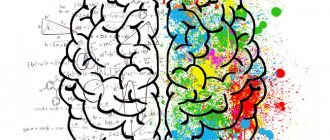Aphonia is a defect in which the patient can only speak in a whisper. This pathology occurs due to paresis of the laryngeal muscles, which narrow the glottis. As a result of their weak tone, the vocal folds do not close completely, leaving a space through which air passes when exhaling.
Types of aphonia
- True aphonia
- Paralytic aphonia
- Functional aphonia
- Spasmodic aphonia
Decoding some types of aphony
- Psychogenic aphonia
- Functional aphonia
- Hysterical aphonia
Because of this condition, a person speaks in a whisper; it can be of different volumes.
Various local and general diseases predispose to aphonia - they lead to disruption of the innervation of the muscles of the larynx and a weakening of their tone. Often the clinic persists for a long time after recovery and during the rehabilitation period; the defect can be eliminated through long-term training and work with a specialist.
Subtypes of functional dysphonia
What is functional dysphonia? This is a disorder in which the vocal cords do not close, but no inflammatory process is observed. Provocateurs are neurological, endocrine or psychological disorders. Pathology is divided into:
- Hypotonic dysphonia, when the vocal cords lose tone, which is why they do not close. The voice becomes quieter and more hoarse. The condition is explained by age-related changes. Usually found in the older generation.
- Hypertonic dysphonia, in which the tone of the vocal cords is increased, but they are completely closed. As a result, the abdominal and neck muscles are also under constant tension. The patient feels a sore throat, hoarseness and soreness appear, and he constantly wants to clear his throat.
- Hypo-hypertonic dysphonia, when the vocal cords are relaxed and the vestibular cords are tense. The voice becomes rougher and as if compressed. At the same time, dry mouth is a concern, and the rhythm of breathing may be disrupted.
- Spasmodic dysphonia, which is a consequence of psychological trauma or other diseases accompanied by prolonged overstrain of the muscles that provide breathing and sound production. The patients' speech will be unintelligible and hoarse. The voice may tremble and sounds may be distorted.
- Psychogenic dysphonia, which is the body’s response to prolonged psychological stress, for example, stress, depression or fear. In addition to a hoarse voice, there is emotional instability. If the patient has suffered severe stress, psychogenic aphonia is possible.
- Mutational dysphonia, which is diagnosed in adolescents during puberty, as well as in mental disorders in adults. The tone of the voice in this case is unstable. The condition persists for a long time.
Obviously, the classification is made based on the root cause of the disease. Accordingly, therapy will be aimed at eliminating it and normalizing the condition of the vocal cords.
The appearance of organic dysphonia is explained by the inflammatory process in the larynx. In this case, the lumen of the larynx narrows, which leads to a change in voice. Inflammation accompanies injuries and defects in the formation of the vocal cords: for example, this can be an infection, surgery, vascular anomaly, or delayed speech development (SSD).
The structure of the speech apparatus, its ability to function
How does sound formation occur in humans, and why can we pronounce individual words, sentences, texts? Speech sounds and their combinations are produced as a result of contraction of the muscles of the peripheral speech apparatus. When a person inhales, the created air flow enters the larynx, creating nerve impulses that in turn affect the vocal cords. Sound production occurs due to the vibration of the vocal cords, that is, they are the main speech instrument in humans, but far from the only one.
Content:
- The structure of the speech apparatus, its ability to function
- Causes of voice loss: why pathology is formed
- Types of aphonia known to medicine
- Diagnosis, recommendations and treatment of aphonia problems
The entire vocal apparatus consists of a central and executive department. The first is the brain: the cerebral cortex, subcortical structures, brainstem nuclei, nerves, pathways. The peripheral or executive department is a system of speech organs consisting of bones, cartilage, muscles, ligaments and peripheral nerves that contribute to the work of these organs in the process of creating and extracting sounds.
The peripheral speech apparatus is divided into the respiratory section (lungs, trachea, bronchi, diaphragm and intercostal muscles), the vocal section (ligaments), and the articulatory section (it is also called sound-producing: soft palate, lips, tongue, lower jaw, teeth, nasal cavity, pharynx , larynx, hard palate).
Each of the listed organs participates in a well-coordinated mechanism for extracting sounds and giving them a certain sound. For example, the strength, timbre and pitch of the voice depend on the movement of the air flow on the ligaments, on its strength and direction. The articulatory organs are responsible for the nature of pronounced sounds, the fullness of vowels, the hardness and clarity of consonant sounds.
Survey
Patients who have problems with their voice should visit an otolaryngologist-phoniatrist. Also, if indicated, consultation with a neurologist, endocrinologist, or psychologist is necessary. To clarify the diagnosis you will need:
- endoscopy of the larynx;
- acoustic voice analysis;
- electroglottography;
- electromyography;
- blood analysis;
- bacterial culture from the nasopharynx;
- biopsy;
- tracheoscopy.
It is also necessary to be examined by a speech therapist. For functional dysphonia, treatment is prescribed by a phonopedist. Diagnostics will help to clearly determine the subtype of the disease, which is important for determining treatment tactics. Our Center’s specialists are ready to accept patients with this disease and provide the necessary assistance.
Diagnostics
As a rule, the primary diagnosis is carried out by an otolaryngologist. During the examination, the absence of anatomical changes is discovered, after which the patient is examined by a phoniatrist and a psychotherapist. As part of the examination, the following procedures are performed:
- Study of anamnesis. The specialist determines when the disorders appeared, what exactly they are, and whether the clinical picture has changed over time. The doctor excludes signs of organic damage (pain, cough, hyperthermia, intoxication syndrome), identifies traumatic circumstances, and learns about the presence of mental disorders during life.
- Additional examinations. The larynx is examined using special mirrors. The neck is palpated to exclude tumors, signs of inflammation, and lymphadenitis. If infectious pathology cannot be definitively excluded by objective methods, a general blood test, smear microscopy, microbiological analysis, radiography, CT or MRI are prescribed.
- Psychological testing. It is carried out to detect hysteria and signs of neuroticism. Various questionnaires and projective methods are used (Lusher, drawing).
Dysphonia Treatment Methods
Treatment for dysphonia involves medication and physical therapy. Patients with a functional type of disorder (including somatics) can be absolutely healthy. Then medications are simply not needed.
So, treatment of hypotonic dysphonia means that the doctor will prescribe B vitamins. For the hypertonic version of the disorder, they will prescribe some kind of sedatives and antispasmodics. Homeopathic remedies are often used to relieve symptoms.
In the functional form of dysphonia, good results are achieved by external procedures: electrophoresis, amplipulse therapy, magnetic therapy. If necessary, the laryngeal mucosa is directly affected. For this purpose fluctuarization is used.
Inhalations and drip administration of medications directly onto the walls of the larynx help well. Ozone therapy is useful. To relieve muscle spasms in the muscles of the neck and larynx, botulinum toxin injections are given.
To normalize the psycho-emotional sphere and nervous system, acupuncture and massage are prescribed. Perhaps you need the help of a psychologist or psychotherapist. Autogenic training, psychotherapy, and the use of relaxation techniques help with dysphonia.
To restore the voice, phonopedic correction is necessary. The patient will have to strengthen the vocal apparatus and laryngeal muscles, and learn proper breathing. He needs to do breathing and articulation exercises, speech therapy massage, and special exercises.
Prevention
- Prevention of colds (avoiding hypothermia, maintaining a day-night routine, proper nutrition, etc.).
- Timely and professional treatment of diseases of the pharynx and larynx, as well as other somatic diseases that may cause the development of dysphonia.
- Quitting smoking (including electronic cigarettes and hookah).
- Compliance with voice mode.
- Treatment of non-infectious pathologies of ENT organs (polyps, adenoids, etc.).
- Use of personal protective equipment (medical masks) during seasonal outbreaks of diseases.
- Consultation with an occupational pathologist (if there is an occupational hazard).
- Refusal of spicy and fried foods.
Forecasts
Dysphonia goes away forever if help comes on time and the rehabilitation plan is drawn up correctly. Difficulties arise if the patient is again faced with a traumatic factor, if psychological problems are added to this (lack of faith in one’s own strengths and the possibilities of therapy), or if the treatment process has been delayed.
The NeuroSpectrum Center for Children's Speech Neurology and Rehabilitation offers a full examination for the presence of dysphonia, consultations with specialized specialists, as well as comprehensive treatment. Together we will restore the voice, return its timbre and tonality.
Loss of voice
Loss of voice
(aphonia, aphonia, from the Greek phone - sound, voice) - the absence of a sonorous voice while maintaining whispered speech. Voice loss occurs for many reasons. In some cases, due to previous colds, apoplexy and other diseases. In others, it may be after excessive strain on the vocal cords or as a consequence of stress. Loss of voice can develop as a symptom when the vocal cords are damaged by an inflammatory or tumor process, with paresis or paralysis of the lower laryngeal nerve, due to mental trauma.
What not to do if you lose your voice
- You should not drink caffeinated drinks such as coffee, tea, or cola until you have fully recovered. Because caffeinated drinks dehydrate the body.
- You should not smoke, because cigarette smoke irritates your throat even more and dries out your throat. Even secondhand smoke causes irritation and inflammation of the larynx, which can slow down the healing process.
- You should not drink alcoholic beverages because they dehydrate the body and aggravate the course of the disease.
- Avoid places with high levels of dust, smoke, cold air and other possible irritants.
- Vasoconstrictors and countercurrent agents should not be used because they dry out the vocal cords.
- You should not take aspirin, especially if the loss of voice occurs after loud screaming. It is possible that a capillary has been damaged on the mucous membrane of the vocal cords. Aspirin can reduce blood clotting and cause bleeding.
- You should not eat foods with a high acid content, such as tomatoes, chocolate, citrus fruits (lemon juice in combination with honey is an exception).
What is aphonia?
Scientifically speaking, aphonia is a condition when the voice loses its sonority. Often, a person can speak in a whisper, but sometimes this function is absent. During a cough, sounds may appear, but with certain diseases it is silent. Sometimes, during a conversation, a sick person will hear subtle notes, but in most cases there is no sound of a voice.
Dysphonia has a slightly different meaning, as timbre changes in the voice are called. A person is able to make sounds, but his voice sounds hoarse, nasal or hoarse. This condition is characterized as a partial loss of voice, while aphonia is a complete absence of sound.
Symptoms
In addition to the inability to speak loudly, the following symptoms occur:
- pain in the larynx;
- difficulty swallowing;
- spasms in the vocal cords.
When symptoms of aphonia appear, the doctor’s task is to search for the causes of this pathology, because this disorder is a consequence of another disease - neurological, mental, functional or organic.








